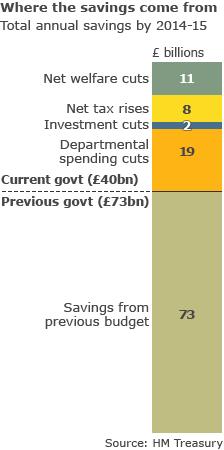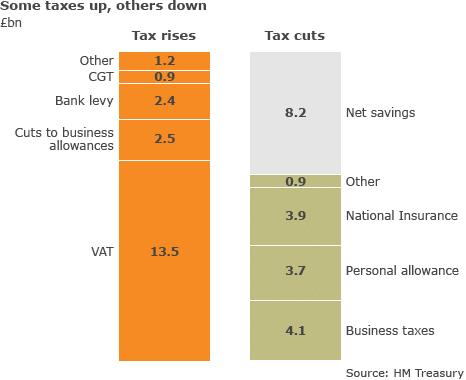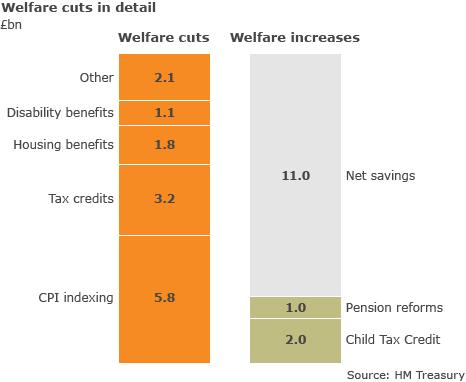The Budget in numbers
- Published
George Osborne says his Budget is needed to avoid a financial disaster in the UK similar to the problems hitting continental Europe.

His Budget is certainly aggressive, and will result in an enormous fiscal squeeze totalling 8.4% of GDP over six years.
But how significant is the coalition's first Budget in the context of the total deficit, and the previous government's Budget plans?
And which of Mr Osborne's many new policies will deliver the biggest savings to the government?
10.1%
is how much the Office of Budget Responsibility (OBR) expects the government deficit to be this year as a percentage of GDP.
Of that figure, 4.8% is the structural deficit that George Osborne's Budget is intended to tackle.
The structural deficit - which is the part expected to be impervious to economic recovery - is the largest of all the countries in the G7.
Another 2.7% is the cyclical deficit, which should disappear of its own accord as the economy recovers boosting tax revenues and reducing unemployment benefit payments.
£40bn
is how much George Osborne expects to cut from the budget deficit by the 2014-15 tax year.
But even before the latest Budget, the previous government's plans were expected to result in £73bn by that year.
That means, adding together Labour's legacy with Mr Osborne's plans, the total fiscal tightening by 2014-15 will be £113bn - an unprecedented amount.
Forecasts
70.3%
is where the OBR thinks government debt will peak as a share of GDP in 2013-14, once the Budget measures come into effect.
Without George Osborne's Budget, the OBR says this debt measure would have reached 74.4% by 2014-15, and still be rising.
But the OBR's deficit and debt forecasts are very sensitive to how strong the UK's economic recovery is.
2.3%
is the OBR's forecast for average GDP growth next year.
That is lower than the 2.6% it was assuming for 2011 under the previous government's Budget plans, because the new government's cuts will be faster and more savage.
But the OBR thinks growth will then rise to 2.8% on average from 2012, and the Consumer Prices Index (CPI) measure of inflation will return to the Bank of England's target of 2%.
But if the recovery turns out to be more sluggish than this, as Labour warns, all of the OBR's deficit forecasts could turn out to be far too rosy.
Tax Rises
£13bn
is what the rise in VAT to 20% should bring into government coffers in the 2014-15 tax year.
That is the biggest chunk of the government's tax plans.
And unlike many other Budget measures, the VAT rise will start bringing in cash from as soon as next year.

The next largest earner will be the proposed bank levy, set to raise £2.4bn per year by 2014.
However, the bulk of the extra revenues earned through these tax rises will be offset by tax cuts elsewhere.
£8.2bn
is how much the government will actually save by 2014-15 through tax changes, once all of the tax cuts are taken into account.
Falls in corporation tax and the small profits rate will give £4.1bn per annum back to businesses by 2014-15.
However, this will be tempered by cuts in the allowances that companies can claim against their tax bills, which are expected to raise £2.8bn.
The partial reversal in Labour's planned hike of National Insurance will lose the government £3.7bn in annual revenues by 2014.
The rise in the personal allowance by £1,000 will lose another £3.9bn per annum, and that ignores the possibility of further rises in the allowance up to £10,000, as promised in the Liberal Democrat manifesto.
Spending Cuts
80%
of George Osborne's planned savings are expected to come from spending cuts by 2014-15.
That compares with the 71% share under the former Labour government's plans.
Mr Osborne plans a massive £31.9bn annual net spending cuts by 2014-15 in total.
Of that figure, £11bn will come from welfare benefits (more detail on that below, and another £2.2bn from reductions in government investment programmes.
But it won't be clear where most of the pain will be felt until the Comprehensive Spending Review is complete in October.
25%
is the total cut in budgets being imposed on nearly all government departments over the next four years under the combined force of the new Budget and plans inherited from Labour.
Only the Health and International Development departments will be exempt from this unprecedented across-the-board slash in spending.
Departmental spending cuts are expected to net a whopping £20.9bn per annum by the 2014-15 tax year.
Welfare Cuts
£11bn
is how much the chancellor expects to cut annually from government welfare payments by 2014-15.

The biggest gain to government coffers will come from the switch from RPI (the Retail Prices Index) measure of inflation to the typically lower CPI as the favoured inflation measure used to index benefit payments.
The gain to the government from this change will increase each year - as the two indices increasingly diverge - reaching a total saving of £5.8bn by 2014-15.
The next biggest cuts in descending order will be in tax credits (£3.2bn in 2014-15), housing benefits (£1.8bn) and the Disability Living Allowance (£1.1bn).
But like the tax changes, reform to welfare is a mixed bag, with cuts in some places partly balanced by rises elsewhere.
£2.9bn
is the total amount being cut from benefits for children in 2014-15, including tax credits, Child Trust Funds, and maternity grants.
But of that figure, a full £2bn will be given back to the lowest income households via an increase in the Child Tax Credit.
Pensioners will also get something back from the government.
The Lib Dem triple guarantee on state pension increases, together with changes to the minimum income guarantee, will deliver £1bn in annual extra spending on pensions by 2014-15.